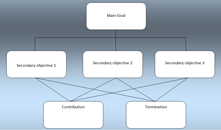1.  |
A COPRAS-F base multi-criteria group decision making approach for site selection of wind farm
, Pages 1-10 Nikhil Chandra Chatterjee and Goutam Kumar Bose |
|
Abstract: Today global warming is on the rise and the natural resources are getting consumed at a faster rate. Power consumption has increased many folds to cater the human need. Thus renewable energy resources are the only option available at this juncture. Wind energy is one of the renewable energy. Location selection for wind farm takes an important role on power generation. However, the location selection is a complex multicriteria problem due to the criteria factors which are conflicting in nature as well as uncertain. The process becomes more complex when a group of decision makers are involved in decision making. In the present study, a COPRAS (COmplex PRoportional ASsessment) based multi-criteria decision-making (MCDM) methodology is done under fuzzy environment with the help of multiple decision makers. More specifically, this study is aimed to focus the applicability of COPRAS-F as a strategic decision making tools to handle the group decision-making problems. DOI: 10.5267/j.dsl.2012.11.001 Keywords: MCDM, Fuzzy MCDM, Multi Criteria Group Decision making (MCGDM), COPRAS-F, Wind Farm Location |
|
2.  |
A fuzzy compromise programming approach for the Black-Litterman portfolio selection model
, Pages 11-22 Mohsen Gharakhani and Seyed Jafar Sadjadi |
|
Abstract: In this paper, we examine advanced optimization approach for portfolio problem introduced by Black and Litterman to consider the shortcomings of Markowitz standard Mean-Variance optimization. Black and Litterman propose a new approach to estimate asset return. They present a way to incorporate the investor’s views into asset pricing process. Since the investor’s view about future asset return is always subjective and imprecise, we can represent it by using fuzzy numbers and the resulting model is multi-objective linear programming. Therefore, the proposed model is analyzed through fuzzy compromise programming approach using appropriate membership function. For this purpose, we introduce the fuzzy ideal solution concept based on investor preference and indifference relationships using canonical representation of proposed fuzzy numbers by means of their correspondingα-cuts. A real world numerical example is presented in which MSCI (Morgan Stanley Capital International Index) is chosen as the target index. The results are reported for a portfolio consisting of the six national indices. The performance of the proposed models is compared using several financial criteria. DOI: 10.5267/j.dsl.2012.12.001 Keywords: MCDM, Fuzzy MCDM, COPRAS-F, Portfolio optimization, Black-Litterman optimization, Markowitz optimization, Fuzzy compromise programming |
|
3.  |
Improved teaching learning based optimization for global function optimization
, Pages 23-34 Suresh Chandra Satapathy and Anima Naik |
|
Abstract: Teaching–Learning-Based Optimization (TLBO) is recently being used as a new, reliable, accurate and robust optimization technique scheme for global optimization over continuous spaces. This paper presents an improved variant of TLBO algorithm, called Improved Teaching–Learning-Based Optimization (ITLBO). A performance comparison of the proposed method is provided against the original TLBO and some other algorithms. The improved TLBO algorithm shows a marked improvement in performance over the traditional TLBO on several benchmark optimization problems. DOI: 10.5267/j.dsl.2012.10.005 Keywords: Optimization technique, TLBO, Convergence, Performance |
|
4.  |
Developing a multi stage mathematical production management model for auto industry
, Pages 35-44 M.Ghorbani Salanghooch, A.Norang and M. Moameni |
|
Abstract: In this paper, we establish an integrated mathematical production management model based on five parts insisted of finished goods production in production sites, inventory control of finished goods in production and distribution facilities, semi-finished goods production in producer’s facilities, inventory control of raw materials in production sites and Inventory control of semi-finished products. The main goal of developed model is to minimize total cost of company in the mentioned parts. Finally, the model is validated with 7 real-world case studies from auto-industry in one of the largest Iranian car producer company, Iran Khodro co and the empirical results are illustrated at the end of the paper. DOI: 10.5267/j.dsl.2012.10.003 Keywords: Production management, Inventory management, Khorasan razavi, Iran Khodro Iranian Company |
|
5.  |
Corporate governance attributes, firm characteristics and the level of corporate disclosure: Evidence from the Indian listed firms
, Pages 45-58 Sunil Nandi and Santanu Kumar Ghosh |
|
Abstract: This study investigates the association between firm characteristics, corporate governance attributes and the level of corporate disclosure of listed firms in India. The research paper has been based on a sample of 60 firms listed in the Bombay Stock Exchange (BSE) / National Stock Exchange (NSE) during the study period from 2000-01 to 2009-10. The study has used the Standard & Poor (2008) model for measuring the level of corporate disclosure. To examine the association between explanatory variables and the level of corporate disclosure, multiple regression model has been used. The results suggest a positive relationship between board size, ratio of audit committee members to total board members, family control, CEO duality, firm size, profitability, liquidity and the extent of corporate disclosure. However, the degree of corporate disclosure is negatively related to board composition, leverage and age of the firm. DOI: 10.5267/j.dsl.2012.10.004 Keywords: Firm characteristics, Corporate governance attributes, Corporate disclosure, India |
|
